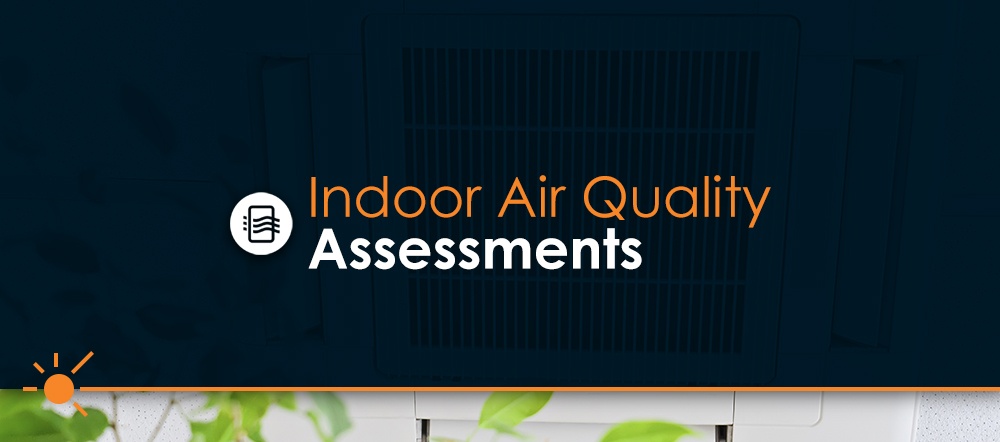
The indoor air quality (IAQ) of your building is critical to the health of your occupants. Due to the risk of air contamination from mold, bacteria, COVID-19, microorganisms, and more, it is important to test air quality.
The following contaminants could be in a building:
- Mold
- Formaldehyde
- Bacteria
- Waste from unwanted pests
- Asbestos
- Fiberglass
- E.coli
- Norovirus
- MRSA (Methicillin-resistant Staphylococcus aureus)
- Legionella (bacteria causing Legionnaires’ disease)
- COVID-19 virus (99.4% effective – tests concluded in June 2020)
- Microorganisms
- Mold spores
As a business owner or facility manager, you could increase your occupants’ productivity and reduce adverse health effects within your school, business, or organization through a commercial indoor air quality assessment and the implementation of airborne pathogen mitigation solutions. Once you have a clear picture of your workspace condition, you can make more informed decisions about the necessary steps to maintain your facility.
What Is an Indoor Air Quality Assessment?
The purpose of an indoor air quality assessment is to identify issues in the air quality of your facility areas and develop long-term solutions to promote the health and safety of your building occupants. This process involves collecting air samples, examining human exposure to pollutants, gathering samples on building surfaces, and studying the airflow.
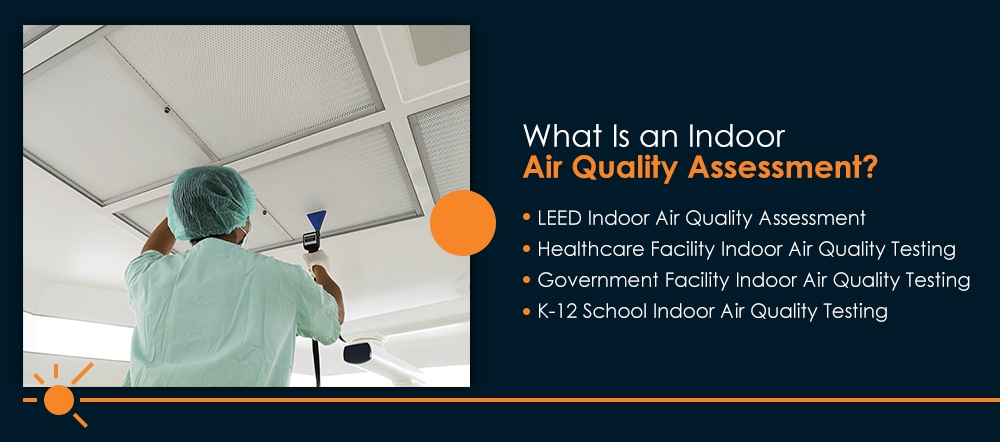
Schools, commercial and industrial buildings, doctor’s offices and hospitals, higher education institutions, restaurants, government facilities, housing units, and retail locations need additional care because of their high population and risk of pathogens. Factors as simple as a faulty HVAC system, resulting in airborne contamination, could compromise the IAQ of your commercial area.
During an IAQ assessment, specialists look for the following:
- Airborne contamination
- Signs of visible mold and water damage
- The moisture of building materials
- Temperature and relative humidity
- Carbon monoxide and carbon dioxide
- Volatile organic compounds (VOC)
- Photographic evidence of visual observations
- Recommendations for remediation
- Residue from rodents and other pests
Learn About SitelogIQ’s Indoor Air Quality Solutions
1. LEED Indoor Air Quality Assessment
The Leadership in Energy and Environmental Design (LEED) is a certification program that promotes environmentally-friendly construction. When your facility has good indoor air quality, your employees, merchandise, and patrons will be safe and comfortable. To test the IAQ of a commercial building after construction and before occupancy to receive LEED certification, your maintenance staff must completely clean the property and complete all construction projects — including movable furnishings, millwork, acoustic tiles, millwork, doors, and paint.
Specialists will inspect your building, particularly the HVAC system, which affects the IAQ of a commercial area through its filtering and dehumidifying capabilities. After reviewing the maintenance records and testing the heating and air conditioning unit, the specialist team will interview site personnel to understand your company’s habits and environmental conditions. Then, they’ll consider potential hazards and develop a cost-effective and permanent solution for maintenance.
2. Healthcare Facility Indoor Air Quality Testing
Besides common contaminants, if you are the manager of a healthcare facility, your team also needs to be aware of the pathogens and biohazardous chemicals that medical staff handle regularly. If your organization doesn’t handle them properly, oxygen and anesthetic gases that your surgeons use during procedures could be a fire or explosion hazard to a healthcare facility. Our specialists from SitelogIQ use careful research and observation to evaluate pollution from both inside and outside of your healthcare facility, primarily through the HVAC system.
The HVAC system in your healthcare facility provides a comfortable environment for the commercial space, allowing your employees and patients to maintain a comfortable temperature. Along with heating and cooling, it also controls your office’s IAQ by filtering allergens from the outside and controlling the humidity in the air. If it doesn’t work properly, the system could draw excessive dust from outside into your building, and too much moisture in the air could also cause mold and mildew growth.
Our Engineered Infection Protection (EIP) of airborne contamination can provide a solution for the IAQ of your healthcare facility. We use a multi-tiered approach that can address the specific indoor air quality issues that your office or hospital may be experiencing.
3. Government Facility Indoor Air Quality Assessments
A government facility is any property that the government owns or has constructed for federal, state, and local purposes. At your facility, the IAQ must comply with the Clean Air Act (CAA), a federal law that promotes controlling air pollution and emissions. To ensure your location follows the CAA and other standards from several health organizations, our specialists will test airborne gases, vapors, particles, and thermal conditions that affect the health, comfort, and productivity of your employees.
As a result of these tests, our facility experts may recommend using environmentally friendly products in place of VOCs. Your location should have an IAQ representative who accounts for the quality of the indoor environment. Creating an indoor air profile of the building and targeting potential sources of pollutants could help preserve the institution’s air quality.
4. K-12 School Indoor Air Quality Testing
The IAQ of your school could affect the concentration and productivity of teachers and students. Children could miss school if they experience allergic reactions and asthma attacks from dust, mold, or mildew. Pathogens can also travel quickly through a large student body, keeping many kids at home sick instead of learning in the classroom. Since schools have limited budgets and additional constraints brought on by the pandemic, you need a cost-effective, practical way to test and improve the air quality of your educational facilities.
To diagnose the IAQ problems in a K-12 school, our specialized IAQ teamat SitelogIQ has the licensing and certification to handle all contaminants, including lead and asbestos remediation, to comply with federal regulations for professional services. We can examine the school’s HVAC system and identify potentially hazardous areas to improve the IAQ of your educational facilities.
Benefits of Indoor Air Quality Assessments
The average person spends around 90% of their time indoors, especially during the workday. Indoor air quality assessments will enhance the overall well-being of your staff, whether you run a healthcare facility, government facility, hospital, retail location, apartment complex, or school. Your occupants should feel confident that they’re in a healthy environment. Consider these benefits of inspecting and improving the IAQ in a commercial facility to better take care of your team and other building occupants.
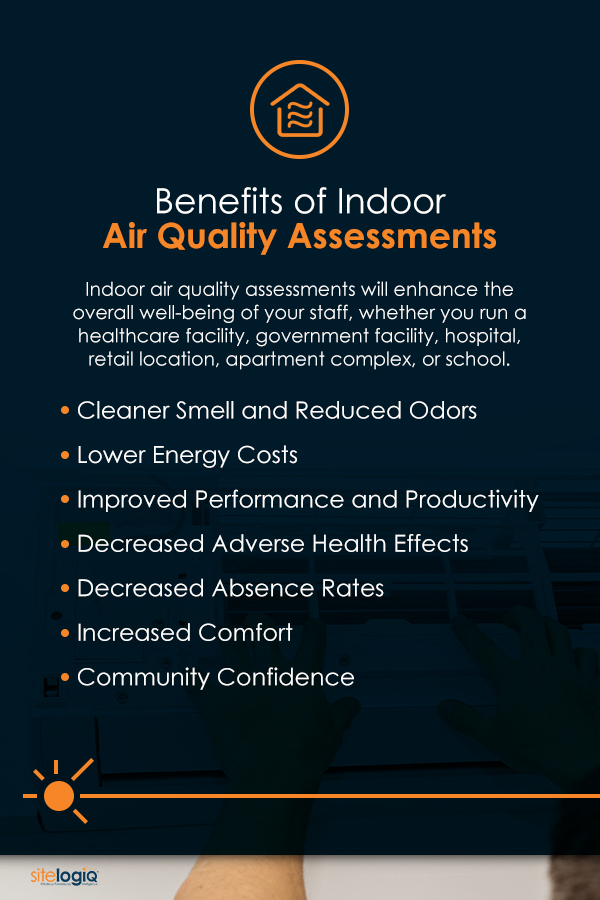
1. Reduced Odors
A strong odor is one of the first signs your employees will detect to indicate poor IAQ in the facility. Most of the time, the smells come from mold and mildew, but Volatile organic compounds (VOCs) in adhesives, paints, cleaning agents, or flooring could also be a culprit. The annoying odors resulting from degraded building materials or moisture damage can decrease the comfort of your employees during the workday, which could lead to a decline in productivity.
Detecting and fixing issues in the IAQ of your commercial facility can provide cleaner air for your employees to breathe, instead of distracting odors that could hinder their work. Keep track of the smells throughout your commercial facility by considering the following questions:
- What type of scent do you or your employees smell?
- How does it impact your activities and health?
- How potent is the smell?
- How does the weather affect the potency of the odor?
- When and where do you sense the smell the most?
During your IAQ assessment, you could give this information to one of our specialists to better detect the contaminants in the air and on surfaces.
2. Lower Energy Costs
During an indoor air quality assessment, our team will often recommend cleaning or replacing the HVAC system to improve the air filter’s functionality. The reliability and energy-efficiency of your company’s HVAC system could enhance the IAQ by reducing the allergens and moisture in the facility. When the HVAC system works efficiently, it needs less energy to run, which will reduce your company’s utility bills. EnergyIQ (EIQ) offers data-driven energy optimization solutions to lower utility costs to access the power your company needs.
For a school with a limited budget, you can further stretch your resources by cleaning or replacing your heating and air conditioning unit. Upgrading to energy-efficient HVAC equipment could cut your energy bill significantly. Promote a better IAQ by removing debris from your HVAC’s air filter and cleaning out the ducts of your system at least once a month.
3. Improved Performance and Productivity
A slight reduction in temperature, relative humidity, and indoor pollutants could increase your employees’ productivity by 2 to 4%. The improved air quality could give your employees or other occupants more energy and increase their ability to concentrate and be productive. Instead of experiencing discomfort from pollutants or allergens, or fatigue caused by the indoor environment conditions, they will receive filtered air that allows them to be more comfortable and focus on their tasks.
According to studies regarding building science, besides the absence of contaminants in the air, the temperature of a room could affect your employees’ productivity and health. Office employees who are satisfied with the thermal environment tend to be more productive at their jobs, and they are less likely to develop illnesses from being too hot or too cold.
4. Decreased Adverse Health Effects
If your employees are sick when they come into the office, it could be more than allergies. Your healthcare facility, hospital, government facility, and K-12 school could have a poor indoor air quality. Improving the IAQ in your workplace by eliminating pathogens and harmful VOCs could relieve these severe symptoms in your employees:
- Allergies and asthma
- Chronic obstructive and pulmonary diseases
- Headaches from chemicals in building materials
- Airborne respiratory infections
- Itchy eyes and runny noses from mold spores
- Cardiovascular mortality and morbidity
- Serious respiratory illness from VOCs, excessive moisture, lack of maintenance, or poor ventilation
- Chronic effects, including lung cancer, from long-term exposure to environmental tobacco smoke, radon, asbestos, or benzene
By reducing the adverse health effects in your employees, you’ll lower risk and increase productivity. More importantly, you’ll show your personnel that you care about their well-being enough to discover long-term solutions to providing a safe environment for them.
5. Decreased Absence Rates
When your employees aren’t comfortable in a work environment, they’re more likely to call in sick, which is costly for your organization. The Environmental Protection Agency (EPA) claims that, around the country, poor IAQ costs companies tens of billions of dollars annually in decreased productivity and medical care expenses. Instead of losing money and harming your employees, you can pursue solutions through an IAQ assessment to bring your employees back to work and ready to do their jobs.
Besides absence from work, dealing with the IAQ in educational facilities could reduce the absenteeism of your students. Proper ventilation can reduce the allergies and asthma a child has to keep them in school. By investing in an indoor air quality assessment for your school, you could increase students’ testing scores and shape their future by providing them with a safe, healthy place to learn.
6. Increased Comfort
The proper IAQ of your commercial building is more than the absence of hazardous contaminants in the air. It also involves providing a comfortable temperature by reducing excess moisture and heat in the air. In an area with poor IAQ, employees may complain of being too hot or too cold and may experience irritation from low humidity.
While complaints of stuffy air and dryness are difficult to measure because it involves the comfort level of each employee, they could indicate a problem with the IAQ of your commercial facility. By assessing the IAQ, you’ll deal with the issues affecting your employees so that they feel valued, appreciated, and comfortable.
7. Community Confidence
As the owner of a company or institution, it is important to have a strong reputation among your community. Taking the proper steps to improve the IAQ of your building shows your community that you care about the well-being of your employees and clients. The removal of mold and other harmful contaminants in your commercial property will enhance your customers’ confidence in your business. When you’ve earned your community’s trust, they’ll be more willing to invest in your products and services.
Commercial IAQ Solutions
Due to reduced IAQ in commercial buildings from the coronavirus, business owners are more aware of the need for practical solutions to create a safe environment for employees, patients, clients, and students. As we as a nation await what the new normal will look like for commercial facilities, as a manager, you need to learn how to clean your facilities properly and assess potentially contaminated areas so our economy and educational institutions can thrive.
Consider these long-term IAQ solutions that we offer at SitelogIQ to get rid of asbestos, mold, viruses, and other contaminants:
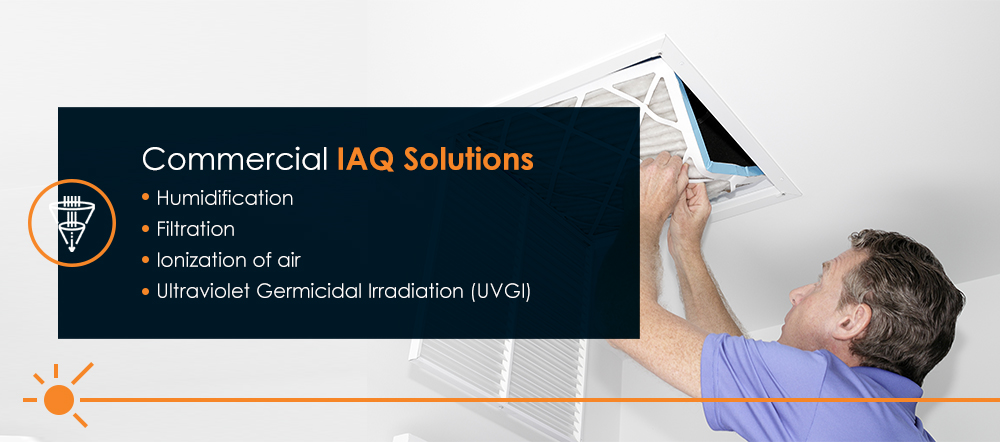
- Humidification: Low humidity could increase the risk of infection in the winter, while high humidity could cause mold or mildew growth. Our team will help you establish the ideal humidity levels for your commercial area.
- Filtration: The quality of the filter in your HVAC system determines how well your unit removes airborne particles from the outside as it transfers air into your building. We’ll assess your HVAC’s filtration system and help you keep pathogens and allergens away from your workspace.
- Ionization of air: Ionization is the process by which we create natural hydroxyls that kill airborne pathogens within a commercial work environment.
- Ultraviolet Germicidal Irradiation (UVGI): The process of UVGI involves removing infectious microorganisms by rendering them inactive before the HVAC filters the air. UVGI can take place in your HVAC units or upper air zones, such as in attics or abnormally large ceilings.
Contact SitelogIQ to Learn More About Our Indoor Air Quality Assessment Services
At SitelogIQ, we specialize in efficiency powered by intelligence, including pathogen mitigation solutions that will help your school, healthcare facility, government facility, or hospital bounce back from common viruses and infections. When dealing with pathogens and contaminants, there is no one-size-fits-all method. Rather, we use a multi-tiered approach to mitigate the pathogens from your facility, implementing various short-term and long-term cleaning technologies.
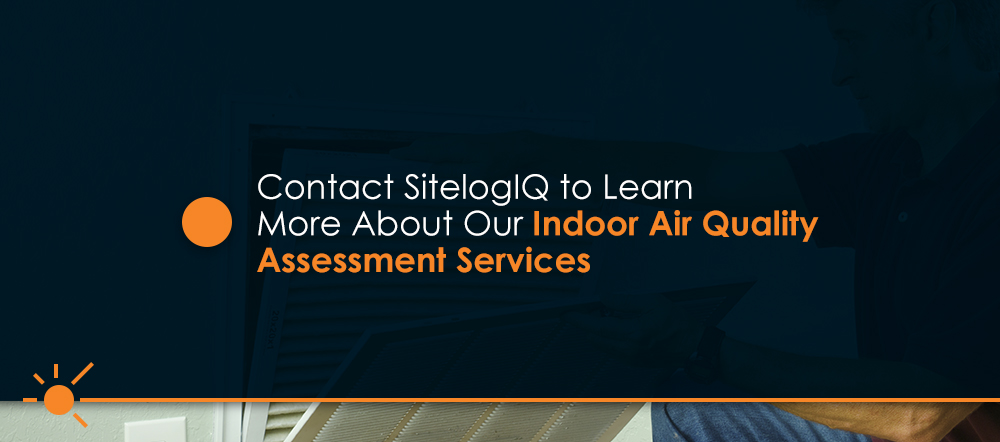
If you suspect that your commercial area has contamination related to mold or other harmful substances, we will assess your property and provide solutions for your IAQ and energy-efficiency. We will also offer services that ensure well-maintained facilities so all of your mechanical systems operate at optimal performance levels. For more information about the services we provide, contact us online or call 888-819-0041.


